Must have been the tempestuous night I started in the morning to a gentle wake. It took a while to collect my bearings: the thatched roof tapered towards the top, quartered window frames girded by coir, bamboo-matted partitions, wood slab flooring. An air conditioner thrummed somewhere. Unfamiliar contours. A throbbing head. The bed swayed. A glass bottle rolled across the floor making a muted Bonsho sound; its vivid label on the front alternating with its blank bone-white behind. Rustle. There is a blanket but it is not covering me. I try to pull it but it is snuck somewhere. Else. Attire and footwear are everywhere. Strewn. I am cold. I remember asking for a blanket on unsteady feet while marsh toads croaked all around me. A portly man offered me the one wrapped around him; his lungi lay around his feet. I hesitated.
“Take it,” he assured me. “I have another.”
The bed swayed again like it did through the night. The contours shifted.
“Ask for tea,” a muffled voice rose from the contours. I opened the slightly ajar door featuring more coir in latticework. The moist laden breeze had a shriving effect on a leaden head.
“Good morning.” It was the portly man from the night. The lungi had wound its way up; he wielded a besom with gusto.
“Time for tea?” he asked motioning the handle towards his mouth.
“Yes please,” I replied, a tad rattled.
“Where are we?” I asked as he turned and walked toward the stern where the kitchen was. It was a boat, a houseboat I was on.
“We will leave after breakfast,” he said turning around, both hands tightly wound around the knob, eyes shining. “We are still on the Vembanad only.”
Charging ports
We weighed anchor around noon the previous day. The pier was a draining walk from the pay and park under the hot, humid sun – my goose-stepping enthusiasm was soon diminished to a slouching saunter. I sat on the deck beneath a tethered turning fan straining at the shackles with a rending tick-tick.
“We will head to Cherukayal where we will stop for lunch,” my skipper charted the route map as he expertly backed and wove his way out from the interstices between other parked boats. He continued: “After lunch we will head to Marthanda and from there to Meenappally Kayal where we halt for the night.” His rictus permitted him to go no further; being the server on board he had other things too on his mind. Like some extra dosh.
“You want local toddy? We buy best local toddy.”
Sure, we could.
“You want pomfret? We buy best pomfret.”
Okay, wait. But aren’t you serving us food on board?
“Oh yes we give food. Our cook, best cook.”
The backwaters are basically canals that run parallel to the Arabian Sea coast and winds inland from the coast between Kochi and Kollam. Route options are plenty – for every budget and time constraints. However the most popular ones remain those between Alappuzha and Kumarakom. We were on a day-night trip from Alappuzha which took you around the Kuttanad region, a major rice-growing part of Kerala. The canals are mostly flanked by paddy fields 3 to 10 feet below sea level; the houseboats itself were once barges used to transport rice and other agrarian produce. The water bodies are fringed by coconut and palm trees – where the ‘best toddy’ comes from.
We moored at Cherukayal alongside another boat; not a houseboat but an ugly looking multi-tiered soap dish, the kind of vessel used by human traffickers to smuggle Syrians into Italy, the kind even if impounded or sunk doesn’t dent the trafficker’s bottomlines. They looked probably the longest out at sea after Noah: underwear and blouses, saris and bras laced the railing from bow to stern and back.
“Once summer sets in people from other states hire boats for months and travel around with their extended families,” explained the skipper noticing the shonky looks exchanged. “Because if they stay in their own land they’d be fried.”
I wanted to ask how different was it in Kerala. It would be probably a notch better. Just.
Travel and tourism sites sell backwater cruises as a year-round activity. But the trip I took in March – officially before summer – sambar-ed me on board. April and May? I would be fried pappadom, good to be served with the lunch we were having now. The best time from my experience would be when monsoon peaks – June, July and part of August – when you can watch the downpour from the deck. A massage when it is coming down is more than divine – it is recommended by Ayurvedic traditions too. The cool, moist and dust-free atmosphere apparently opens up skin pores which make the body most receptive to medicinal oils and therapy. And a massage aboard a houseboat? The next best thing is sex.
As dusk fell we approached a narrow strip of elevated bank with the famed paddy fields of Kuttanad region four feet below the water level on the other side. Clutches of banana trees stood like tremulous quiffs in the wind. The whole pier was a parking lot to where houseboats were either already moored or were tottering toward like a gourmand after a feast. We docked next to what looked like a Chinese peasant robot – a short box with a tilted tin top over it. Wires went in and out of it from a crude electric post nearby. These supplied electricity to the houseboats; bedroom air conditioners would be whirring alive soon.
“Most boat owners own the strip of land next to where they drop anchor,” the skipper explained. “This land belongs to our boss who paid lakhs of rupees many years ago.” A new houseboat owner is left with no option but to take on lease these charging ports for big money. I didn’t even want to imagine what those new guys charged their customers.
Coming soon: traffic lights?
At almost 97 km, the Vembanad is the longest lake in India. With 10 rivers feeding it, it is the largest in Kerala with three districts – Alappuzha, Kottayam and Kochi – bordering it. A narrow skerrick of an island separates it from the Arabian Sea. The canals, the backwaters, like the one were on now, linked it to the other lakes along the coast. Just like the intricate system of village roads leading to state highways which go on to join national highways.
Tea in hand I sat on the deck and espied the Vembanad not very far away. A hazy mist blanketed the backwater and the Vembanad looked like the Flying Dutchman would spring out of it any moment. Darters skipped across the surface for a bit before toppling into the water spotting prey. Vying for their prize was lone fisherman in his canoe with his ottal, the traditional cane basket, and fishing net. While the show-off darter created quite a stir the fisherman sat with nary a ripple.
On our way back – which lasted barely an hour – we passed by grocery shops on boats. Fathers took their children to school on boats. Farmers reported for work in the fields by boat. These little caiques usually stuck close to the banks and gave the bulk of way to the houseboats. The houseboats were all in a hurry to get back to wherever they started from. There was incessant honking going on at intersections between houseboats; my captain even gestured censure at another for not going fast enough at a T junction which forced us to slow down.
“We have orders to reach back by 9 AM; then we clean up, buy grocery and tank up for the next trip.” There are customers who arrive without booking and insist on seeing the boat before hiring. “They are the finicky ones and it is easy to lose business here.”
I looked around my room and understood why my skipper was flooring it.
(This travelogue was published in the New Indian Express.)



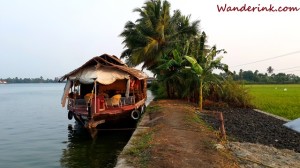
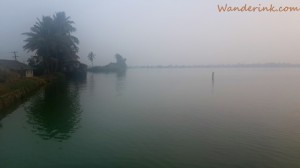
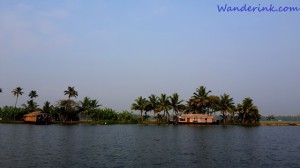
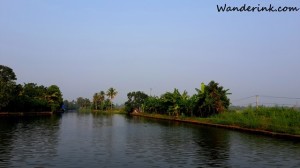
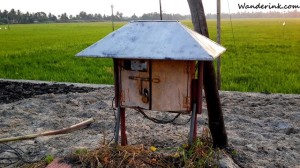
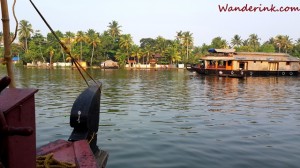










Lovely, long read. Especially liked the single word sentences.May Vembanad never get the imaginary traffic lights.
Thank you, Pragya. Yeah, may Vembanad never…